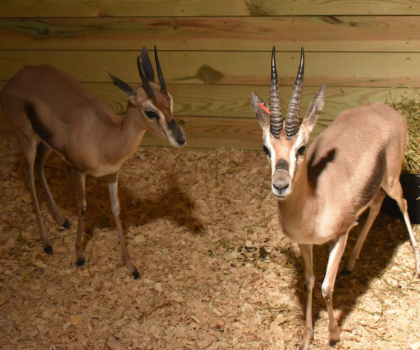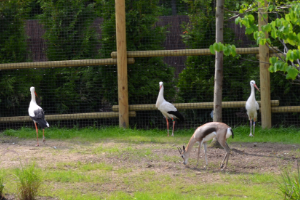Have you ever been introduced to someone new? If you are not introduced well, it can be awkward, uncomfortable and even frightening to meet new people. However, if you are given a thorough introduction, it is much easier to find common ground and begin building a relationship. The same is true for the animals here at our zoo. Taking two animals who have never met and moving them to a shared space can be frightening, and sometimes dangerous depending on the species. This is why many of our animals meet each other slowly through a process called animal introductions.
An animal introduction is when two or more animals who are not currently housed together are given the opportunity to see, smell and touch each other. This allows them to get to know one another before moving into a shared habitat. Introductions are important because animals have unique personalities, just like people, so some are very eager to investigate new animals while others are more shy and can be nervous when approached, or may see a new animal as a threat.
The first step of an introduction is giving our animals the chance to smell each other. This is often done by swapping the animals’ bedding or toys, which carry each animal’s scent.
 The next step is a “howdy” introduction, during which animals are able to see each other but not physically interact. This may be done by replacing a door between the animals’ bedrooms with species appropriate mesh or clear plexiglass. We look for signals that animals are comfortable being near each other. This may be shown by spending calm time near the mesh, or simply ignoring each other and going about their regular business.
The next step is a “howdy” introduction, during which animals are able to see each other but not physically interact. This may be done by replacing a door between the animals’ bedrooms with species appropriate mesh or clear plexiglass. We look for signals that animals are comfortable being near each other. This may be shown by spending calm time near the mesh, or simply ignoring each other and going about their regular business.
If this process goes well, the final step is allowing animals to share a habitat. We give our animals enough space to avoid interaction if they want; it should always be their choice to interact. Habitats provide visual and physical barriers between animals. This lowers stress by allowing our animals to choose when they want to interact and when they would prefer to be alone.
Keepers and behavior specialists monitor animals throughout the process to ensure the safety and welfare of our animals. In general they look for positive behaviors, like play or curiosity from a distance, and are wary of any indicators of stress, aggression or fear, since this may cause animals to run away or injure themselves. We want all animals to appear receptive to the interaction before it progresses. If an initial introduction does not go well, it is evaluated, adjusted, and then tried again under new conditions. In some extreme cases (like Atlantis, our capybara) our animals make it clear that they do not want company, and interactions are ended, but usually animals warm up to each other given time.
Introductions take place for a variety of reasons, including breeding, animal births, animal moves from one habitat to another and new arrivals. Some of our most recent animal introductions have been taking place in the Landon and Cynthia KnightPride of Africa as several new species get ready to make their debut at your Akron Zoo.
 When first introduced to one another, our male Speke’s gazelle was enthusiastic while our female was curious but shy. The two showed no negative indicators, so the introduction progressed smoothly to a physical interaction. The gazelles were given the entire barn to themselves to run around and go into and out of stalls as they pleased. In a short time, the two became comfortable and began to play and groom each other. The two female white storks responded slightly timidly at first to the two males, but their introduction overall was relatively uneventful. The gazelles, storks and guineafowl have all been introduced, and are now enjoying their shared habitat as they eagerly await the opening of Pride of Africa!
When first introduced to one another, our male Speke’s gazelle was enthusiastic while our female was curious but shy. The two showed no negative indicators, so the introduction progressed smoothly to a physical interaction. The gazelles were given the entire barn to themselves to run around and go into and out of stalls as they pleased. In a short time, the two became comfortable and began to play and groom each other. The two female white storks responded slightly timidly at first to the two males, but their introduction overall was relatively uneventful. The gazelles, storks and guineafowl have all been introduced, and are now enjoying their shared habitat as they eagerly await the opening of Pride of Africa!
So join us in Pride of Africa to see how well our animals are getting along, and maybe make a friend yourself (feathered, furry or otherwise)! No introductions necessary to be a part of our pride!
By Erica Rymer, Events & Marketing Specialist. Published July 3, 2019.
